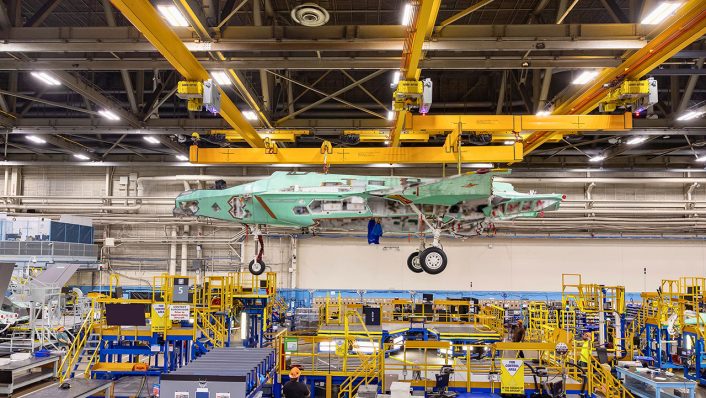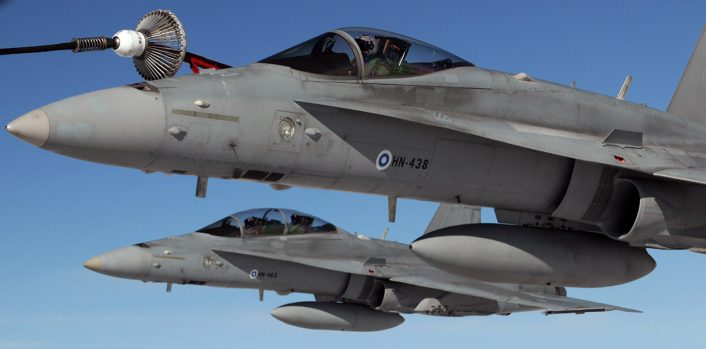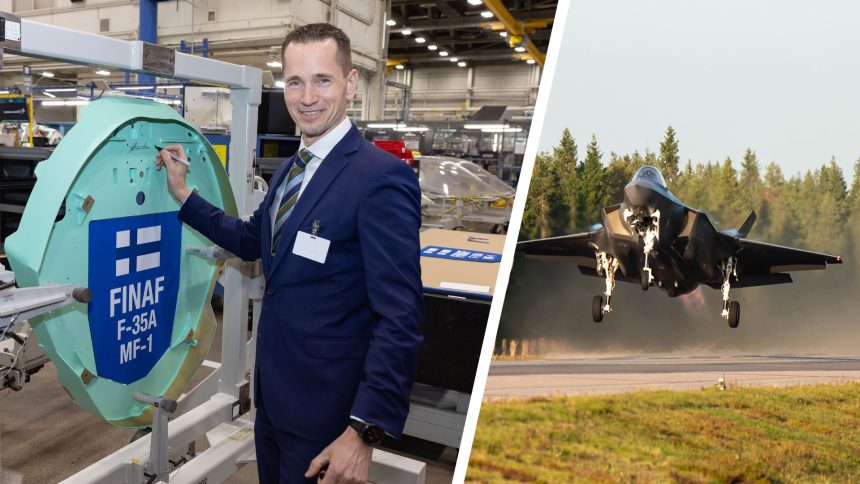The first F-35 Lightning II for the Finnish Air Force, JF-501, is now in production, with roll out expected in 2025. Finland selected the F-35 in 2021 to replace the F/A-18, ordering 64 aircraft.
During a visit to Lockheed Martin’s Fort Worth plant in Texas, USA, on Oct. 28, 2024, retired Finnish Air Force colonel and current Finnish F-35 program director Henrik Elo signed his name on the bulkhead of what will become JF-501, Finland’s first F-35A Lightning II airframe.
JF-501 will soon have its major components mated together using the electronic mate and alignment system before reaching the final assembly phase. The electronic mate and alignment system uses a complex array of lasers and sensors to precisely align and join together the forward fuselage, mid fuselage, wing section and tail section of each F-35.
The airframe is scheduled for completion in Autumn 2025, after which it will roll out of the factory and officially be handed over to the Finnish Air Force. Rather than heading directly to Finland, the next stop for the first Finnish F-35s will be Ebbing Air National Guard Base, Arkansas, where a training unit will be formed.

Finland’s F-35s
Finland has ordered 64 examples of the conventional take-off and landing F-35A variant to replace its current fighter force of F/A-18C/D Hornets, beating competition from Boeing’s F/A-18E/F Super Hornet and Saab’s Gripen E/F.
The Finnish Air Force ordered its Hornets in 1992, with approximately 55 F/A-18Cs and 7 F/A-18Ds remaining in service today out of the 64 in total ordered. Notably, this means that the F-35 order is, accounting for attrition, a like-for-like replacement in terms of numbers, contrasting many nations who have ordered fewer F-35s than the jets they are replacing.
All of Finland’s F-35s will be delivered equipped with the Technology Refresh 3 (TR-3) package. TR-3 is a major electronics upgrade for the F-35, offering higher processing power and an open architecture philosophy which will allow quicker and simpler integration of future technologies, sensors and weapon systems onto the type.
Speaking at the Fort Worth plant, Henrik Elo noted the symbolic but important milestone in the delivery of his country’s new aircraft: “I am very pleased that we are progressing in building the various capability areas of our F-35 as planned. The forward fuselage signing event is a minor but symbolically important milestone in the manufacturing process of the aircraft fleet.”
According to the current schedule, Finland will see its first delivery of F-35s touch down at Rovaniemi Airport by the end of 2026. There they will join HävLLv 11 (11 Squadron) of the Lapland Air Wing, which guards the airspace of Finland’s northern territory. Karelia Air Wing, based at Kuopio Airport in south-east Finland, will receive its F-35s from 2028.
These bases, which are Finland’s only two full-time operational fighter bases, are both around one hundred miles from the Russian border, and ideally placed to launch fighters for intercept tasks over the Barents and Baltic seas. With Finland’s recent accession into NATO, the nation has taken an active role in the alliance’s joint air defence initiatives and this integration will likely continue in the future.

National industry’s involvement
While the vast majority of Finland’s Hornets were assembled locally by Finnish state-owned manufacturer Patria, this will not be the case for the F-35. Though final assembly of the airframes will take place in the USA, Patria will join the global supply chain by establishing a production facility for F-35 forward fuselage sections and landing gear doors. According to Petri Hepola, Chief Program Officer at Patria for the F-35, this will be the first international F-35 facility producing forward fuselage sections. Parts produced by Patria will be shipped to the Fort Worth plant to be integrated onto Finnish F-35s as well as F-35s of other nations.
Patria has also signed a deal with Pratt & Whitney, producer of the F-35’s F135 engine, to produce engines locally at a facility in Nokia from 2025. This will evolve into a hub for the maintenance, repair, overhaul and upgrade of F135 engines from 2030.
Drag chute modification
When JF-501 is handed over, Finland will become the thirteenth nation to take delivery of the fifth generation fighter and, based on current orders, they will eventually be the fifth largest operator of the type. Finland will join a small selection of F-35 operators using the drag chute modification pioneered by and currently unique to the Royal Norwegian Air Force. Only Norway, Finland and Canada are presently confirmed to have chosen the option, owing to their cold climates. The drag chute, which is housed in a small fairing between the aircraft’s twin tail fins, is designed to assist braking on potentially icy runways.
Interesting: Finnish Air Force F-35 model features drag chute fairing (seen also on Norwegian F-35As). Some background about the drag chute here: https://t.co/GyzKeebtCL https://t.co/OZqoJMpHEe pic.twitter.com/a2UNIt7BQm
— The Aviationist (@TheAviationist) June 15, 2024
While any external fairing will affect the F-35’s stealth characteristics to some degree, Lockheed Martin says the drag chute system has been designed to minimize its impact to the overall radar cross-section (RCS) of the aircraft. In any case, as with F-35s flying with external loads, the RCS would still be lower than a previous generation fighter in a similar configuration.
Notably, although the base was chosen for testing the drag chute modification, the U.S. Air Force’s F-35s at Eielson Air Force Base, Alaska are not equipped with the feature. Two units, the 355th and 356th Fighter Squadrons, operate a total of 54 F-35As from the Alaskan base. The co-located squadron of F-16s that also fall under the 354th Fighter Wing recently underwent a redesignation from the 18th Aggressor Squadron to the 18th Fighter Interceptor Squadron.
The newly rebadged 18th FIS was soon seen undertaking air defense identification zone (ADIZ) protection sorties monitoring Russian activity over the Bering Sea and surrounding areas. The F-16s share Alaskan ADIZ duties with the F-22 Raptors of Joint Base Elmendorf-Richardson, who, with the increased frequency of intercepts in recent years, have no doubt welcomed the support. Having the F-16s available to backfill the Elmendorf Raptors on alert duties has additionally allowed the F-22s, a scarce resource in the U.S. Air Force, to deploy on overseas detachments without affecting homeland air defence.
Increased Russian activity is of course also present in the European theatre, especially following the invasion of Ukraine. This will be one particular reason Finland looks forward to its F-35s entering service.









